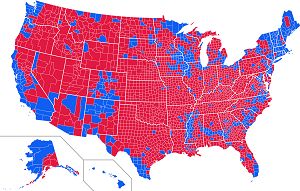What The Urbanization of the Nation Means for American Politics Today

In response to How State, Federal Courts Are Working to End Partisan Gerrymandering, published July 13, I received several emails and Facebook messages questioning the statistic that the United States is now over 80 percent urbanized by population.
While this seems like a huge number, it came from the 2010 Census, which found that:
The urban areas of the United States for the 2010 Census contain 249,253,271 people, representing 80.7% of the population, and rural areas contain 59,492,276 people, or 19.3% of the population. - U.S. Census FAQs
Urbanization is growing, with the CIA projecting continuous growth through 2030.
But what does it mean politically -- and more importantly, is this really that different from the way things have always been?
Building Myths Around Our Past Doesn't Change Reality--We've Always Been Urbanized
For some reason, the popular myth of the American colonial homesteader, complete with raccoon-skin cap, was the popular way of portraying American history, from the Revolution to the present day.
In the tenth census, however, there is a population density map of how the United States was in 1790 -- at the time of the first census.
Populations were heavily dense around the coast, and primarily centered on the larger cities.We tend to have the causation of urbanization backwards in our mindset -- that in reality, people first congregated in settlements, only then to expand into the wilderness in smaller groups.
Even during later periods of westward expansion, settlers congregated in the cities as staging areas before departing on all three of the great westward trails, leaving from Independence, Missouri (Oregon Trail), Franklin, Missouri (Santa Fe Trail), and Nauvoo, Illinois (Mormon Trail).
At times, people would live in these staging areas for several years, building up the supplies needed for the westward trek.
The courage of these pioneers who left civilization as they knew it to tame the unknown cannot be underestimated, and surely plays a large part of the glamorization of their efforts. They were looking to better themselves and their families -- pioneers of the American Spirit.
The Mechanization of Farming: Modern Urbanization
In 1900, with a national population of 76 million, 38 percent of the population lived on farms -- a high percentage, but definitely not the majority.
By 1940, this dropped to 18 percent, and continued to drop to its present day figure of 2.6 percent of the total population.
The 20th century was marked by mechanization in farming, something that had already taken place in the factories of the cities.
No longer was most of the work done by hand, but instead done by machines -- pulled at first by horse teams, later by motorized tractors.
This glut in farm workers was part of the underlying causes of the Great Depression, and forced thousands of unemployed farm workers into the cities looking for work.
Even farm owners were affected; small outfits couldn't compete and often went under. The age of the corporate farm with vast tracks of land was beginning. No longer could a family easily stay self-sufficient on a small, family-owned farm.
Why Does This Matter in 2015?
One of the most consistent political memes that floats around social media after each national election is the one showing the United States by county (or state) with the title, "But the map is mostly Red..."
And in fact, geographic area-wise, the United States is mostly conservative. But overlay a map with the large cities on it and we see almost instantaneously that the root cause of this, for the most part, is the urban/country divide -- especially true in the South and Atlantic states.
In modern New York, the urban/country divide is so profound that 6 of the 27 congressional districts take up more than 80 percent of the state's geographical area, while the urban districts fall primarily along the cities and are geographically compact.
Like the rest of the United States, New York tends to trend mostly conservative in rural ares, and mostly liberal in the cities.
What we tend to forget is that this is the way it was at the founding of the Republic. The Federalists tended to hold the cities as their strongholds, Anti-Administration (and later Democratic-Republicans) held the country.
From the very beginning, drawing of congressional lines along geographic boundaries created a functional form of governance that helped keep large swaths of the electorate from being totally disenfranchised.
In the election of 1793 (special election year), had the House of Representatives been at-large seats, the Federalists in New York would have won all 10 seats. Yet, because of the formation of districts, the Anti-Administration was able to hold 3 of the 10 seats (still less than their 48 percent of the vote).
The Connecticut Compromise, which defined the bicameral legislative structure of Congress, was not about protecting the rural areas, who were quite content with the setup of the Articles of Confederation (one state, one vote). It was about protecting the fact that the more populous states believed they should have greater say in the political process.And so we come full circle in 2015 -- to the way it was in the very beginning. Each state with equal footing in the Senate, the more populous states having more power in the House. But even in the populous states, with the design of congressional districts, the rural areas still have significant protection.
As America continues to urbanize, we need to remember that the Founding Fathers paid very close attention to this phenomenon, spending more time debating this issue than most others. The attitudes and beliefs that go along with city/country life can be profound, but the Founders dealt with it in the only way they knew how: By compromising and staying engaged in the political process.
Photo Credit: blvdone / shutterstock.com






